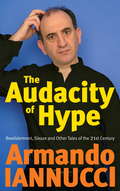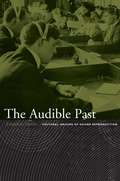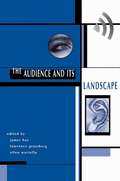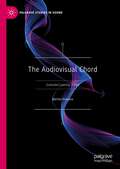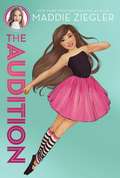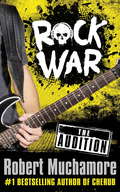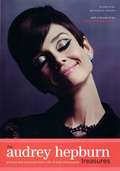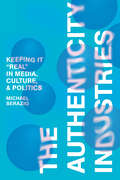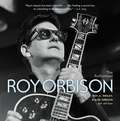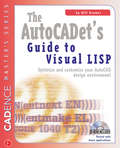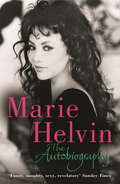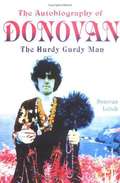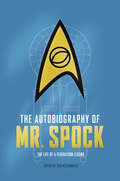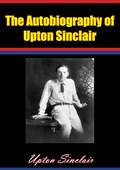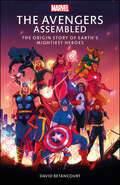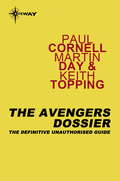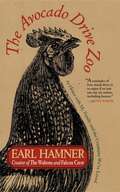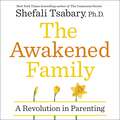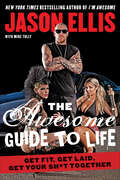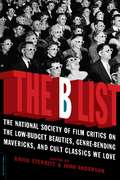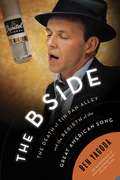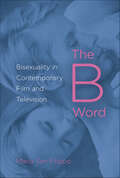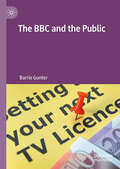- Table View
- List View
The Audacity Of Hype: Bewilderment, sleaze and other tales of the 21st century
by Armando IannucciIn THE AUDACITY OF HYPE, Armando Iannucci cuts straight to the heart of the insanity and sherbet-headed nonsense of modern life. THE AUDACITY OF HYPE brings together his views on diverse subjects, ranging from wickedly funny pen portraits of the sometimes loveable, usually despicable chumps who like to think of themselves as our political elite, and their bonkers schemes to save the world that are in fact likely to do us more harm than a pile of witches, to WMD, disaster movies, the pitfalls of 'I'm A Celebrity, Get Me Out Of Here' and the high and mighty rhetoric of Obama, this is an absurdly entertaining and utterly indispensable collection from one of Britain's most brilliant satirists.
The Audible Past: Cultural Origins of Sound Reproduction
by Jonathan SterneThe Audible Past explores the cultural origins of sound reproduction. It describes a distinctive sound culture that gave birth to the sound recording and the transmission devices so ubiquitous in modern life. With an ear for the unexpected, scholar and musician Jonathan Sterne uses the technological and cultural precursors of telephony, phonography, and radio as an entry point into a history of sound in its own right. Sterne studies the constantly shifting boundary between phenomena organized as "sound" and "not sound. " In The Audible Past, this history crisscrosses the liminal regions between bodies and machines, originals and copies, nature and culture, and life and death. Blending cultural studies and the history of communication technology, Sterne follows modern sound technologies back through a historical labyrinth. Along the way, he encounters capitalists and inventors, musicians and philosophers, embalmers and grave robbers, doctors and patients, deaf children and their teachers, professionals and hobbyists, folklorists and tribal singers. The Audible Past tracks the connections between the history of sound and the defining features of modernity: from developments in medicine, physics, and philosophy to the tumultuous shifts of industrial capitalism, colonialism, urbanization, modern technology, and the rise of a new middle class. A provocative history of sound, The Audible Past challenges theoretical commonplaces such as the philosophical privilege of the speaking subject, the visual bias in theories of modernity, and static descriptions of nature. It will interest those in cultural studies, media and communication studies, the new musicology, and the history of technology.
The Audience and Its Landscape (Cultural Studies)
by James HayThis book offers a major reconceptualization of the term “audience,” including the landscape of a given audience—the situated and territorializing features of any way of seeing and defining the world. Given de Certeau's hypothesis that listening, watching, and reading all occur in places and result in produce transformed paths or spaces, the contributors to this landmark volume have provided innovative essays analyzing the transformations that take place in the geography between sender and receiver. The book acknowledges, in the face of conventional “discourse analysis,” the contextual features of discourse, to produce a complex and textured understanding of the concept of audience.The Audience and Its Landscape, presents the work of a vital cross-section of international scholars including Sweden's Karl Erik Rosengren, the UK's Jay G. Blumler and Roger Silverstone, Australia's Tony Bennett, Israel's Elihu Katz, Canada's Martin Allor, and the United States's Janice Radway, Byron Reeves, and John Fisk, to name a few. This book is truly groundbreaking in its depth and scope, and will speak to students of rhetoric, mass communication, cultural studies, anthropology, and sociology alike.
The Audiovisual Chord: Embodied Listening in Film (Palgrave Studies in Sound)
by Martine HuvenneThis book is a phenomenological approach to film sound and film as a whole, bringing all sensory impressions together within the body as a sense of movement. This includes embodied listening, felt sound and the audiovisual chord as a dynamic knot of visual and auditory movements. From this perspective, auditory spaces in film can be used as a pivot between an inner and an external world.
The Audition (Maddie Ziegler #1)
by Maddie ZieglerFrom Dance Moms star and So You Think You Can Dance: The Next Generation judge Maddie Ziegler comes the first novel in a brand-new middle grade trilogy about friendship, dance, and going after your dreams.Twelve-year-old Harper has been dancing practically since she learned to walk. She loves her dance studio and team, and just won her first ever top junior solo in a regional competition. But right before the school year starts, Harper’s parents drop a bombshell—the family has to relocate from their cozy town in Connecticut to sunny Florida for their jobs. That means saying goodbye to her friends, dance team, trips to see shows in NYC—and did she mentioned dance team? While her parents reassure her that they will find her a new studio as soon as they move, Harper is not happy. When she arrives, she realizes that the competition in Florida will be fierce and it doesn’t matter how talented she is—she is the new girl and will have to prove herself. During her very first class, Harper finds it harder than she thought it would be. Even though they are all the same age and have been dancing for roughly the same amount of time, it feels like everyone has better feet, quicker turns, and faster taps than Harper. And it doesn’t help that a group of girls, who nicknamed themselves The Bunheads, wonder how she made the team if she can’t even do a simple turn sequence in front of the class. Thankfully, Harper befriends Lily, a fellow newbie in the studio who is just as eager to make her mark and find a friendly face. With a big competition coming up for the dance team, Harper is determined to show everyone—especially those Bunheads—what she’s made of! And when a very badly timed sprained ankle threatens all of the work they have done, the Bunheads, Lily, and Harper must learn to truly work together to give them their best shot at the top spot!
The Audition: World Book Day 2014 (Rock War #100)
by Robert MuchamoreTwo kids, one band, one crucial audition. Noah's a natural on the guitar, and he'd give anything to get through the Rock War audition. But when he betrays his best friend to join another band, he knows he's crossed the line. Will he risk their friendship for the sake of musical stardom?Introducing new characters, a never-before-seen band, and a behind-the-scenes look at the Rock War auditions, in a story written especially for World Book Day.
The Audrey Hepburn Treasures
by Jessica Z. Diamond Ellen Erwin Sean Hepburn FerrerWith nearly thirty movies, countless awards, and an unwavering commitment to UNICEF, Audrey Hepburn's life served as an example of both style and purpose. From her early dance performances for the Dutch resistance during World War II to her London cabaret days and her breakthrough roles inGigiandRoman Holiday,audiences worldwide have long been enchanted by Audrey's charm and grace. Now, in this lavishly illustrated biography -- created with the Audrey Hepburn Children's Fund -- Audrey's own words are given center stage to create a unique personal narrative. This special collection also includes approximately 200 black-and-white and color photographs selected by the Hepburn Estate, as well as reproduced mementos from Audrey's life. Thirty-four removable documents include an excerpt from herBreakfast at Tiffany'sscript with handwritten notes, a letter she sent to husband Mel Ferrer while preparing forThe Nun's Story,and a birth certificate announcement marking the arrival of her first son. A dazzling celebration of an extraordinary human being,The Audrey Hepburn Treasuresoffers fan an intimate and revealing portrait of the woman they admire and adore.
The Authenticity Industries: Keeping it "Real" in Media, Culture, and Politics
by Michael SerazioIn recent decades, authenticity has become an American obsession. It animates thirty years' worth of reality TV programming and fuels the explosive virality of one hot social media app after another. It characterizes Donald Trump's willful disregard for political correctness (and proofreading) and inspires multinational corporations to stake activist claims in ways that few "woke" brands ever dared before. It buttresses a multibillion-dollar influencer industry of everyday folks shilling their friends with #spon-con and burnishes the street cred of rock stars and rappers alike. But, ironically, authenticity's not actually real: it's as fabricated as it is ubiquitous. In The Authenticity Industries, journalist and scholar Michael Serazio combines eye-opening reporting and lively prose to take readers behind the scenes with those who make "reality"—and the ways it tries to influence us. Drawing upon dozens of rare interviews with campaign consultants, advertising executives, tech company leadership, and entertainment industry gatekeepers, the book slyly investigates the professionals and practices that make people, products, and platforms seem "authentic" in today's media, culture, and politics. The result is a spotlight on the power of authenticity in today's media-saturated world and the strategies to satisfy this widespread yearning. In theory, authenticity might represent the central moral framework of our time: allaying anxieties about self and society, culture and commerce, and technology and humanity. It infects and informs our ideals of celebrity, aesthetics, privacy, nostalgia, and populism. And Serazio reveals how these pretenses are crafted, backstage, for audiences, consumers, and voters.
The Authorized Roy Orbison
by Alex Orbison Roy Orbison Wesley Orbison Jeff SlateFor the first time, legendary performer Roy Orbison's story as one of the most beloved rock legends will be revealed through family accounts and records. p.p1 {margin: 0.0px 0.0px 0.0px 0.0px; text-indent: 36.0px; font: 12.0px Geneva} p.p2 {margin: 0.0px 0.0px 0.0px 0.0px; font: 12.0px Geneva} span.Apple-tab-span {white-space:pre} Roy Orbison is a rock and roll icon almost without peer. He came of age as an artist on the venerable Sun Records label; toured with The Beatles; had massive hits in the 1960s, 1970s, and 1980s; invented the black-clad, sunglasses-wearing image of the rock star; and reinvented the art of songwriting many times over. He is a member of the Rock & Roll and Songwriters Halls of Fame, a recipient of the Musicians Hall of Fame's inaugural Iconic Riff Award, and the winner of multiple GRAMMY® awards. He is known the world over for hits like "Blue Bayou," "You Got It," and "Oh, Pretty Woman" and was a member of the band that inspired the term "supergroup"-the Traveling Wilburys, with Bob Dylan, George Harrison, Jeff Lynne, and Tom Petty. Despite these and countless other accolades, the story of Roy Orbison's life is virtually unknown to his millions of fans around the world. Now, for the first time ever, the Orbison Estate, headed by Roy's sons, Wesley, Roy Jr., and Alex Orbison, has set out to set the record straight. The Authorized Roy Orbison tells the epic tale of a West Texas boy, drawn to the guitar at age six, whose monumental global career successes were matched at nearly every turn by extraordinary personal tragedies, including the loss of his first wife in a motorcycle accident and his two oldest sons in a fire. It's a story of the intense highs and severe lows that make up the mountain range of Roy Orbison's career; one that touched four decades and ended abruptly at perhaps its highest peak, when he passed away at the age of fifty-two on December 6, 1988. Filled with hundreds of photographs, many never before seen, gathered from across the globe and uncovered from deep within the Orbison Vault, The Authorized Roy Orbison shows Roy Orbison as a young child and follows him all the way through to the peak of his stardom and up to his tragic end. Wesley, Roy Jr., and Alex Orbison-Roy's Boys-have left no stone unturned in order to illustrate the people, places, things, and events that forged their father, the man behind those famous sunglasses.
The AutoCADET's Guide to Visual LISP (Cadence Masters Ser.)
by Bill KramerAutoCADet: A person who uses AutoCAD directly or indirectly to create or analyze graphic images and is in possession of one or more of the following traits: wants to learn; has an interest in improving the way AutoCAD works; is a visionary AutoCAD user; i
The Autobiography
by Marie HelvinOne of the original supermodels and international fashion icons, Marie Helvin has been an iconic image in every decade since the 1970s. She was a Hawaiian hippie child in the 60s, a magazine cover star in the 70s, a society supermodel in the 80s, a pioneer detox guru in the 90s and a reluctant reality TV contestant in 2006.In each decade she found herself in the company of the brightest and the best. Still at the forefront of the fashion industry, she is as much in demand as ever, most recently modelling for her seventh British Vogue cover.Marie's autobiography candidly tells the story of friendships with the rich and famous. She reveals the dark side of her own personality as she explains how, gradually, she came to believe in her own beauty and found fulfilment as an independent woman.Illustrated with photographs from many of the greats, including Bailey, Helmut Newton and Nick Knight, Marie Helvin's memoir is a remarkable story of our times.
The Autobiography
by Marie HelvinThe candid and revealing autobiography of supermodel Marie HelvinOne of the original supermodels and international fashion icons, Marie Helvin has been an iconic image in every decade since the 1970s. She was a Hawaiian hippie child in the 60s, a magazine cover star in the 70s, a society supermodel in the 80s, a pioneer detox guru in the 90s and a reluctant reality TV contestant in 2006.In each decade she found herself in the company of the brightest and the best. Still at the forefront of the fashion industry, she is as much in demand as ever, most recently modelling for her seventh British Vogue cover.Marie's autobiography candidly tells the story of friendships with the rich and famous. She reveals the dark side of her own personality as she explains how, gradually, she came to believe in her own beauty and found fulfilment as an independent woman.Illustrated with photographs from many of the greats, including Bailey, Helmut Newton and Nick Knight, Marie Helvin's memoir is a remarkable story of our times.
The Autobiography of Donovan: The Hurdy Gurdy Man
by Donovan LeitchDonovan's autobiography charts his life from a post-war, Glaswegian childhood to the height of an international career as one of the leading figures of the 1960's music scene. He found relief through music and poetry. The book reveals how he came to be influenced by Buddhist teachings, and the music of Woody Guthrie and Joan Baez. The book explores his deep love with the woman who was to become his muse, and the profound sense of loss he felt when their relationship came to an end.
The Autobiography of Mr. Spock
by Una MccormackThe iconic Star Trek character&’s lifestory appears for the first time in his own words; perfect for fans of the upcoming Star Trek: Strange New Words. One of Starfleet&’s finest officers and the Federation&’s most celebrated citizens reveals his life story. Mr Spock explores his difficult childhood on Vulcan with Michael Burnham, his controversial enrolment at Starfleet Academy, his time on the Enterprise with both Kirk and Pike, and his moves to his diplomatic and ambassadorial roles, including his clandestine mission to Romulus. Brand-new details of his life on Vulcan and the Enterprise are revealed, along with never-before-seen insights into Spock&’s relationships with the most important figures in his life, including Sarek, Michael Burnham, Christopher Pike, Kirk, McCoy and more, all told in his own distinctive voice.
The Autobiography of Upton Sinclair
by Upton SinclairFirst published in 1962, on the suggestion of his readers throughout his expansive writing career, this is the self-penned biography of Upton Sinclair, author of hundreds of novels, plays, homilies, diatribes and pamphlets.Written at the age 83, Sinclair at last allows his loyal readership to glean an in-depth look at the man who discovered the Jungle in Armours Meat Industry at 28, founded a Utopian co-operative in 1908, and who muckraked through all of America "to become the finest and most devoted polemicist this country has seen"--from his childhood beginnings in Maryland to his youth in New York through to publication of his first novels and political career and beyond.Of his work, Upton Sinclair says: "The English Queen Mary, who failed to hold the French port of Calais, said that when she died, the word 'Calais' would be found written on her heart. I don't know whether anyone will care to examine my heart, but if they do they will find two words there--'Social Justice.' For that is what I have believed in and fought for during sixty-three of my eighty-four books."His is an intellectual's book dealing with one who made intellectual history, and no self-respecting intellectual tradesman will fail to read it."--Kirkus ReviewIllustrated with 17 black-and-white photographs.
The Avengers Assembled: The Origin Story of Earth’s Mightiest Heroes
by David BetancourtA new, in-depth, biographical take on the greatest Superhero team of all timeEver wondered who the Avengers really are…?Take a deep dive into the fascinating history of Earth's Mightiest Heroes. From their earth-shattering formation and cataclysmic lineup changes to the introduction of fan-favorite characters like the Vision and Black Widow, this unique volume provides a comprehensive look at the origin and evolution of Marvel's premiere Super Hero team.This meticulously researched biography reveals unparalleled insights into the characters, backstories and motivations of Iron Man, Captain America, Ant-Man, Wasp, Thor, Hulk, Scarlet Witch, Black Widow, Black Panther, and more. The Avengers&’ story has been told many times – but never like this…© 2023 MARVEL
The Avengers Dossier
by Paul Cornell Keith Topping Martin DayMore than any other series, THE AVENGERS typified the Swinging Sixties - beginning in 1961 with Patrick Macnee starring with Ian Hendry in a grainy, realistic spy thriller, and ending in 1969 with Macnee and the glamorous Linda Thorson blasting off into space in a surreal episode appropriately entitled 'Bizarre'. Meanwhile we had seen the memorable Honor Blackman and Diana Rigg in roles unusually progressive for British television.THE NEW AVENGERS in the mid-seventies reflected changing times but retained the essence of the show - as Macnee returned to play alongside another strong, independent heroine in the form of Joanna Lumley's Purdey. And then there was the film...THE AVENGERS DOSSIER is a uniquely comprehensive yet humorous survey of all the show's incarnations. As well as a remarkably detailed episode guide to both series - even covering the kinkiness factor and champagne count in both - this volume gives behind the scenes insights and revelations about every aspect of the programme. The film and its production are examined, and critical essays look at the history behind the cult.
The Avocado Drive Zoo: At Home with My Family and the Creatures We've Loved
by Earl HamnerThe Avocado Drive Zoo is a warm and personal, yet humorous, recounting of how Earl Hamner, his wife, Jane, and their two children have lived with and loved the animals in their lives. From the beginning, Hamner and his wife shared an uncommon love and respect for animals, and as their family grew, so did the number of their pets. By the time they moved to Hollywood and settled into a lovely residence on Avocado Drive, their home was much like a "zoo." Among the colorful cast of animals who have lived with the Harmers have been Jane's possessive cocker spaniel pup, Clementine, who bit Earl as he proposed marriage; twelve box turtles from Virginia; bantam hens and roosters and a baby chick named 'Mackie; and Talmadge the mouse whose gluttony ended an unusual relationship with the family. And then there was Gus the horny dog whose amorous inclinations brought on his early demise; Willie the family rat; Yarrow the white labrador; a family of coyotes; Surprise the cat who nearly decimated their family of pet rats; Raymond the rabbit and George the guinea pig who were soul and crate mates; the alligator who lived in their bathtub; and a host of other unnamed pets and critters. The Avocado Drive Zoo is filled with the warmth, love, and respect the Hammers have for the animals they have known. By the last page of this wonderful, charming book it is obvious that not only have animals enriched the Hammers' lives, but they are a resource for all families, providing parents and children with opportunities to grow in love, understanding, and respect for one another--and for the creatures who share our world.
The Awakened Family: How to Raise Empowered, Resilient, and Conscious Children.
by Dr Shefali TsabaryDr Shefali teaches us how to control our expectations, embrace the present moment, and let go of the anxiety surrounding how best to parent our children.Become the awakened parent you've always wanted to be and watch your children thrive.All parents have aspirations for their children but for some these hopes turn into unrealistic expectations. In many cases, this puts huge amounts of pressure on children and has the potential to cause real harm, hindering your child's development. Challenging modern myths on how kids should be, Dr Shefali helps parents recognise children for who they truly are instead of holding onto society's impossible ideals.Drawing on Eastern philosophy as well as Western psychology, Dr Shefali offers enlightened, practical advice and explains her radically transformative plan which guarantees that you have confident children and a calm and emotionally connected family.(P)2017 Penguin Random House Audio
The Awe-Inspiring Beauty of Tom Cruise’s Shattered, Troll-like Face
by Chuck KlostermanOriginally collected in Sex, Drugs, and Cocoa Puffs and now available both as a stand-alone essay and in the collection Chuck Klosterman on Film and Television, this essay is about modern films and reality.
The Awesome Guide to Life: Get Fit, Get Laid, Get Your Sh*t Together
by Jason Ellis Mike TullyIn the same inimitable, uncensored, and hilarious style that has made him one of the most popular voices on satellite radio, Jason Ellis unleashes his no-holds-barred words of advice on diet and exercise, cultivating your signature look, partying, getting laid, maintaining a relationship—and more!Maybe—like Jason Ellis—you want to have sex with multiple partners and then talk about it on the radio while wearing cheetah pants . . .Or maybe you have some goals of your own. Whatever the case may be, Jason believes it's all about getting off your ass and maximizing the opportunities that life has to offer. It's about remembering that you are alive, right now, and that won't always be the case. So do something. Anything. Enjoy the ride. Go outside and get naked.Jason can tell you how to handle every situation life throws at you and play it like a champ: how to look, how to act, how to pick up a stripper—you name it.But that's just for starters. Jason believes that to get what you really want out of life, you have to have confidence. And true confidence is something you have to earn, by deciding what you want from life and then pursuing your passion until you make your dreams a reality.This book will show you how to develop the positive attitude that will allow you to truly make things happen.
The B List: The National Society of Film Critics on the Low-Budget Beauties, Genre-Bending Mavericks, and Cult Classics We Love
by John Anderson David SterrittThe choicest noir, neo-noir, science fiction, horror, westerns, midnight movies, and more?from critics like David Ansen, Jami Bernard, Roger Ebert, Carrie Rickey, Richard Schickel, and Kenneth Turan.
The B Side
by Ben YagodaFrom an acclaimed cultural critic, a narrative and social history of the Great American Songwriting era. Everybody knows and loves the American Songbook. But it's a bit less widely understood that in about 1950, this stream of great songs more or less dried up. All of a sudden, what came over the radio wasn't Gershwin, Porter, and Berlin, but "Come on-a My House" and "How Much Is That Doggie in the Window?" Elvis and rock and roll arrived a few years later, and at that point the game was truly up. What happened, and why? In The B Side, acclaimed cultural historian Ben Yagoda answers those questions in a fascinating piece of detective work. Drawing on previously untapped archival sources and on scores of interviews--the voices include Randy Newman, Jimmy Webb, Linda Ronstadt, and Herb Alpert--the book illuminates broad musical trends through a series of intertwined stories. Among them are the battle between ASCAP and Broadcast Music, Inc.; the revolution in jazz after World War II; the impact of radio and then television; and the bitter, decades-long feud between Mitch Miller and Frank Sinatra. The B Side is about taste, and the particular economics and culture of songwriting, and the potential of popular art for greatness and beauty. It's destined to become a classic of American musical history.
The B Word: Bisexuality in Contemporary Film and Television
by Maria San FilippoOften disguised in public discourse by terms like "gay," "homoerotic," "homosocial," or "queer," bisexuality is strangely absent from queer studies and virtually untreated in film and media criticism. Maria San Filippo aims to explore the central role bisexuality plays in contemporary screen culture, establishing its importance in representation, marketing, and spectatorship. By examining a variety of media genres including art cinema, sexploitation cinema and vampire films, "bromances," and series television, San Filippo discovers "missed moments" where bisexual readings of these texts reveal a more malleable notion of subjectivity and eroticism. San Filippo's work moves beyond the subject of heteronormativity and responds to "compulsory monosexuality," where it's not necessarily a couple's gender that is at issue, but rather that an individual chooses one or the other. The B Word transcends dominant relational formation (gay, straight, or otherwise) and brings a discursive voice to the field of queer and film studies.
The BBC and the Public
by Barrie GunterThis book examines the relationship between the public and the BBC in terms of public use of the BBC and their attitudes towards it. These audience research measures are being used as metrics to assess the value of the BBC to the UK public. Some of the attitudinal measures address perceptions of the BBC’s outputs and some examine public views about the way the BBC is funded and managed. The book has been written at a time when the BBC reached its centenary and also the mid-point of its latest Royal Charter period. At the time of writing, the government had begun a mid-term review of its performance as judged by its attainment of objectives set out in that Charter. The Secretary of State for Digital, Culture, Media and Sport at the time of the mid-term review had spoken and written openly about abolishing the TV licence fee and the introduction of a new funding model for the BBC that would be implemented in its new Royal Charter due to be enacted in 2027. Against this backdrop, this book examines public opinion about the funding of the BBC and then looks at changing media consumption habits and how these have affected patronage of the BBC’s outputs. “Ultimately, a decision must be taken about the kind of national broadcaster the UK – both is government and its citizens – would like to keep in the future. Changing the funding model without first defining what the BBC should do and how it should be structured and resourced to do it could result in a messy solution that satisfies and benefits no one.”
